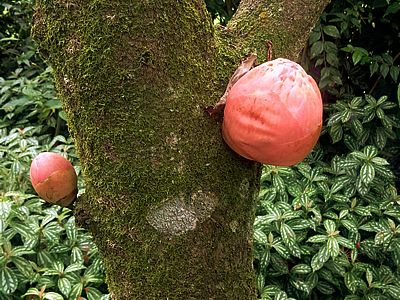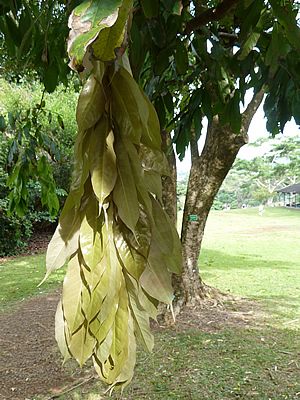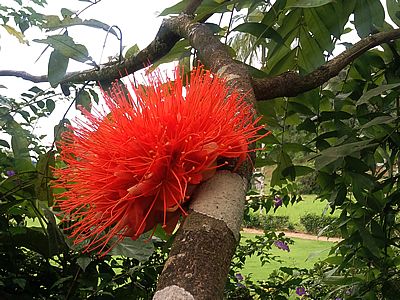The Panama Flame Tree (Brownea macrophylla) is a small, slow-growing ornamental tree that reaches a maximum height of about 33 feet (10 meters). Native to the Amazon region in South America, it spans countries such as Ecuador, Bolivia, Peru, the Guianas, and Venezuela. This species is a member of the Fabaceae family, the same as peas and beans, and is noted for its ornamental characteristics. The bark of its trunk is light brown with horizontal lenticels, and the trunk can reach up to 14 inches (35 centimeters) in diameter. It forms an umbrella-shaped crown with robust branches. The Panama Flame Tree’s pinnate leaves, with 4 to 18 pairs of large, dark green, elliptical leaflets, are a special highlight.

When young, the leaves are pendulous, pale, and spotted, presenting a very curious and attractive look. The inflorescences of the Panama Flame Tree emerge directly from the trunk, forming large and dense disks of red flowers with long stamens, a unique feature of this species. The flowers open from the margin towards the center of the inflorescence, forming a beautiful ball, like a pompom. Blooming occurs throughout the year, peaking in spring. The fruits formed are legumes (pods), large, brown in color, densely covered with hairs, and contain one to two seeds, brown and with a wrinkled surface.
In landscaping, the Panama Flame Tree is a tree to be admired up close, ideal for planting along paths, flanking woods, or even near buildings, where its majestic flowers can be close to viewers. In addition to its aesthetic beauty, the Panama Flame Tree attracts pollinators such as butterflies and bees, contributing to local biodiversity. Its ability to be planted in pots, achieving a smaller size, makes it a versatile option for different spaces in urban landscaping.

Cultivation of the Panama Flame Tree should be done in full sun or partial shade, in fertile, drainable soil, enriched with organic matter, and regularly watered. This species does not tolerate intense cold, heavy frosts, or prolonged dry periods, preferring tropical climates with high environmental humidity. Young Panama Flame Trees grow better under partial shade, protected from the strong midday sun, and as they gain size and vigor, can be gradually exposed to full sun.
Propagation of the Panama Flame Tree is done by seeds, which should be planted as soon as the fruits ripen, as they quickly lose viability. Germination takes about 30 to 60 days to complete. Breaking dormancy in hot water and subsequent soaking can standardize and improve germination rates, a common technique for hard and resistant seeds. The Panama Flame Tree blooms about 3 to 4 years after planting, an aspect to consider in landscape planning.


